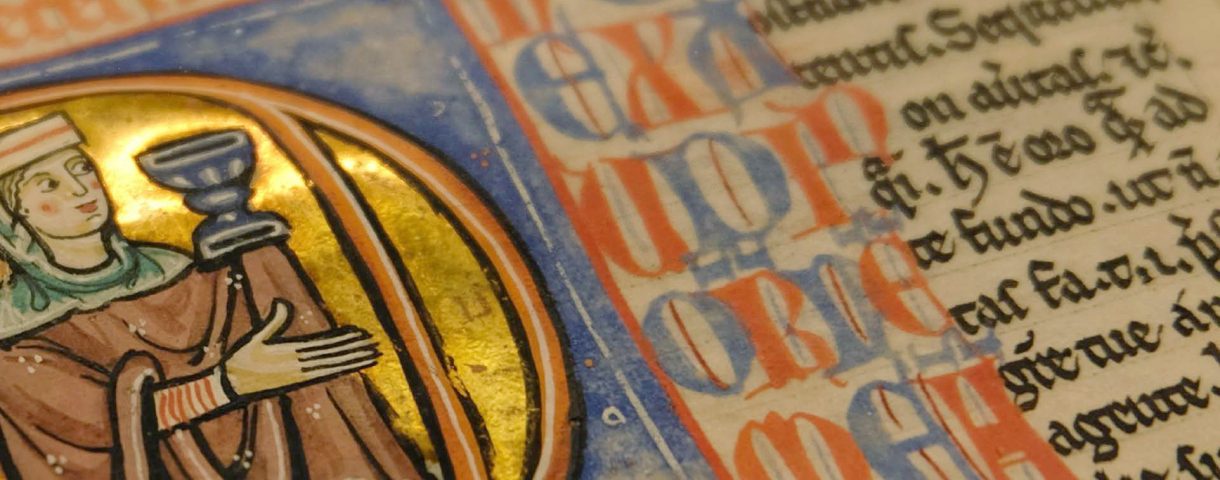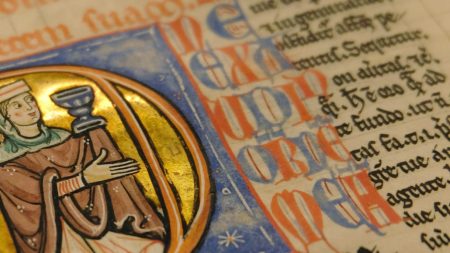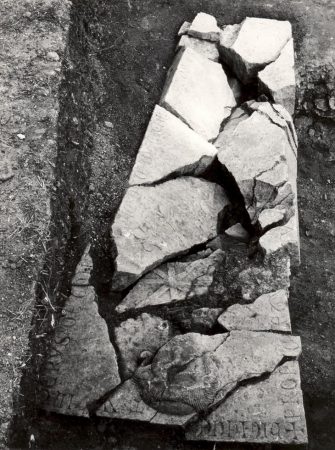Our guest blogger is Alan Welsford, a local resident who has been involved with the Abbey 900 display of manuscripts with us at the museum. Alan is responsible for the idea of bringing Alexendar Neckham further into the spotlight, and via this blog shows the importance of Cirencester, the Abbey, and the medieval manuscripts on display in the Museum until 21st May.
Part One
The Abbey 900 festival commemorates the foundation of Cirencester Abbey in 1117. As part of the Commemoration, Corinium Museum is displaying four medieval manuscripts from the Bodleian Library and Jesus College, Oxford, which were once held in the library of the Abbey of St Mary, Cirencester. The display was sponsored by Soroptimists International: Cirencester District and the transport of the manuscripts was sponsored by Tanners solicitors.
The Abbey was founded in 1117 by Henry I to replace the existing College of Secular Canons at Cirencester with a community of Augustinian Canons. Henry was following Papal preference in choosing the Augustinians to replace the resident secular Canons. The Augustinians differed from their predecessors in that they took the monastic vows of poverty, chastity and obedience: they were known as Canons Regular – that is living under regulation. Each Augustinian community of Canons Regular developed their own precise Rule – the one for Cirencester is not known.
The first dozen or so Canons arrived in 1130 or 1131 from Merton Priory in Surrey, probably using the Anglo-Saxon minster for their church. The foundations of this minster were discovered during the excavations of the Abbey site and revealed the largest yet known Anglo-Saxon church in England as well as extensive foundations of the Abbey church and buildings. (Wilkinson D and McWhirr A. Cirencester : Anglo-Saxon church and medieval Abbey. Cirencester Excavations IV).
Abbot Serlo – the first Abbot of the Abbey
The first Abbot was Serlo whose Abbacy lasted from 1130/1 until 1147. Serlo was probably Dean of Old Sarum and had previously been a Canon of the Augustinian Priory at Merton. The final consecration of the great Abbey church did not happen until 1176 in the presence of four bishops and King Henry II. Work continued for many years to complete the church and provide the full complement of conventual buildings – cloisters, refectory, dormitories, an Abbot’s House and, from our point of view, most importantly, a scriptorium and a library.
The Canons maintained a daily round of religious services, the Opus Dei (The Work of God). These began at midnight with Matins and Lauds, Prime at 6am followed at 9am with Terce, then Sext at noon, None at 3pm, Vespers at 6pm and lastly Compline at bed-time, 9pm. Each developed around the psalms.
Augustinians
The Augustinians were a community of priests, who employed staff to care for the day to day work within the Abbey and had a concern for work in parishes, taking them outside their Abbey, differentiating them from Benedictine monks. At its foundation the Abbey was endowed with many parishes both close by and in more distant places and so had responsibilities for them. Cirencester was one of these and also Cheltenham. On display is the tomb-stone from the grave of one of the Priests serving Cheltenham church who was a member of the Council of Cirencester Abbey though not a member of the community proper.
The Augustinians had a greater emphasis on scholarship than the Benedictines. Augustinian life outside their Abbey brought the Canons into contact with the changes in society stemming from economic developments and new intellectual stimulation. These two factors were to be of some consequence both to Cirencester Abbey and the Church more widely.
Little is known about the Canons who were at Cirencester beyond the Abbots whose roles in securing the influence of the Abbey locally, nationally and beyond are known from the Cartulary and documents preserved in national archives. Some Canons are known only as names which appear in the Ex Libris entries in manuscripts. However, there are some whose names and works establish Cirencester Abbey as a monastery with formidable scholars during the so-called Twelfth Century Renaissance (see Swanson R.N. The twelfth-century renaissance. Manchester University Press. 1999.)
Canon Jocelyn and the first known instance of the idea of zero
One of the scholars at Cirencester was Canon Jocelyn who was probably amongst the Canons of Merton whom Serlo chose to accompany him to set up the Abbey. At Hereford Cathedral Library is a collection of books which belonged to Canon Jocelyn known by its incipit or title: “While some are considering the theory of multiplication and division.” Within this volume is Jocelyn’s copy of De Abaco (On the Abacus) by Gerlandus (c1080). It may be that Canon Jocelyn’s interest in numbers and calculation stemmed from the problems the Church had in determining the correct date for Easter Day – the compotus – and the use of number to elucidate theological issues. It was thought that 1x1x1=1 gave an intuitive understanding of the Christian doctrine of the Trinity. There are nine known medieval copies of Gerlandus: what is especially interesting about Jocelyn’s copy is that it contains a verse for remembering the “new” Hindu-Arabic numerals that we use today. And not only that: it is the only copy which includes “zipos” or zero, which has led to the claim that Jocelyn is the first person known by name to have understood the importance of zero in the new mathematics. At that time Cirencester was in the Diocese of Worcester which was a centre of Arabic studies translating Arabic and Greek texts into Latin. Augustinian Canons had great freedom of movement and so we can wonder if Jocelyn met with other scholars in Worcester Priory (now the Cathedral).
Robert of Cricklade
Another scholar in the earlier days of Cirencester Abbey and whose name we know was Robert of Cricklade. Educated in Cricklade, Robert became a master in the Schools at Oxford which had emerged in the late 11th century, though not yet a University. He entered Cirencester Abbey before 1139 and whilst there wrote his “De connubio Iacob (On the marriage of Jacob). What may have been his own copy survives in Hereford Cathedral Library (Ms P.iv.8.). This work is an allegory on the story of Jacob, one of the Patriarchs in the Old Testament. Robert was amongst the scholars who appreciated the need to examine the Bible in the light of the emerging Aristotelian approach of questioning received opinion. He learned Hebrew which was important in another of his works amongst Cirencester manuscripts now in Hereford (O.iii.10) –Homilie super Ezechielem (Homlies/Sermons on the Book Ezekiel) which shows his knowledge of Hebrew. But this was written after he had moved to be Prior at St. Frideswide’s, Oxford (now Christ Church). Andrew Dunning, in his blog for the British Library, draws attention to Robert’s insistence on the importance of scholarly writing. “Even after Robert’s death (between 1174 and 1180), his work at Oxford and Cirencester inspired the work of the famous Alexander Neckham (1157–1217)”.














Comments
Hello
I am a member of our Historical Society, I see British History Online indicates Henry 1st granted a charter to the Abbey in 1133 in which Milborne (Port) is mentioned, if correct are examples available please.
Regards Hugh